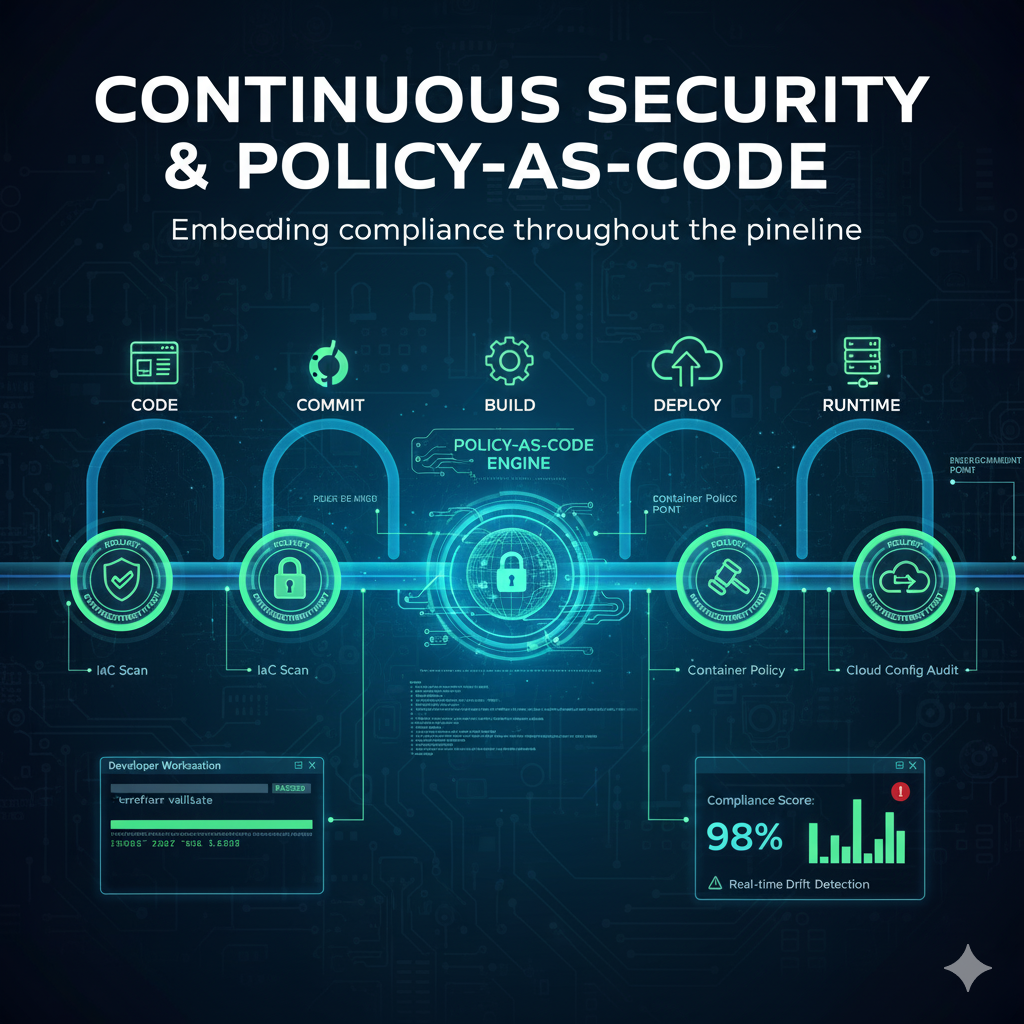Continuous Security and Policy-as-Code: Embedding compliance throughout the pipeline.

In the era of rapid software delivery, organizations are constantly striving for speed and agility. Yet, this pursuit often bumps up against the non-negotiable demands of security and compliance. Traditionally, security was a bottleneck, a gate at the end of the development cycle that often led to last-minute, costly fixes. But what if security and compliance could be seamlessly integrated, even automated, into every stage of the software delivery pipeline?
Enter Continuous Security and Policy-as-Code (PaC) – two powerful paradigms that promise to embed compliance, not just as an afterthought, but as an intrinsic part of the development lifecycle, from commit to production.
The Challenge: Security as an Afterthought
The "traditional" approach to security often looks something like this:
- Develop code.
- Deploy code.
- Run security scans (often manual or late-stage).
- Discover vulnerabilities.
- Go back to step 1 (or 2) to fix.
This reactive model creates significant problems:
- Costly Rework: Fixing issues late in the cycle is exponentially more expensive than addressing them early.
- Slows Down Delivery: Security reviews become chokepoints, delaying releases.
- Increased Risk: Vulnerabilities can sit undetected in production for longer periods.
- Compliance Headaches: Manual compliance checks are prone to error and difficult to audit consistently.
The Solution: Continuous Security
Continuous Security isn't just about running more scans; it's a fundamental shift in mindset. It's about making security an ongoing, integrated process rather than a discrete phase. Inspired by Continuous Integration (CI) and Continuous Delivery (CD), it means:
- Automating Security Testing: Integrating security tools (SAST, DAST, SCA) directly into the CI/CD pipeline.
- Shifting Left: Bringing security practices and checks as early as possible in the development lifecycle – even to the developer's workstation.
- Proactive Risk Management: Identifying and mitigating security risks continuously, rather than reactively.
- Collaboration: Fostering a culture where developers, operations, and security teams share responsibility for security.
But how do we effectively enforce security policies across diverse teams, technologies, and environments in an automated fashion? This is where Policy-as-Code becomes indispensable.
Policy-as-Code: Compliance in Version Control
Policy-as-Code (PaC) is the practice of defining, managing, and automating security, compliance, and operational policies using human-readable, machine-enforceable code. Just as Infrastructure-as-Code (IaC) defines infrastructure, PaC defines rules and guardrails.
Think about it:
- Infrastructure-as-Code (Terraform, CloudFormation): Defines what to build (e.g., "create a VPC with these subnets").
- Policy-as-Code (Open Policy Agent, Sentinel): Defines how it should be built (e.g., "VPC must have encryption enabled," "storage buckets cannot be publicly accessible," "only approved container images can be deployed").
Key Benefits of Policy-as-Code:
- Consistency and Standardization: Policies are defined once and applied consistently across all environments, eliminating human error and drift.
- Automation and Speed: Policies can be automatically evaluated at every stage of the pipeline (code commit, build, deploy), providing immediate feedback and preventing non-compliant changes from progressing.
Version Control and Auditability: Policies are stored in Git, just like application code. This means:
- Full History: Every change is tracked, showing who made it, when, and why.
- Rollback Capability: Easily revert to previous policy versions if needed.
- Collaboration: Teams can propose, review, and approve policy changes collaboratively.
- Audit Trail: Provides clear evidence of compliance for auditors.
- Early Feedback ("Shift Left"): Developers can test their configurations against policies before committing code, catching compliance violations at the earliest, cheapest possible stage.
- Scalability: As your organization grows and expands its cloud footprint, PaC scales effortlessly, applying rules to thousands of resources without manual intervention.
- Reduced Manual Overhead: Frees up security and compliance teams from tedious manual checks, allowing them to focus on higher-value activities.
Embedding Compliance Throughout the Pipeline with PaC
Let's look at how PaC practically integrates into a modern CI/CD pipeline to achieve continuous security:
| Pipeline Stage | PaC Application | Example |
| Code Development | Developers run local PaC checks on their IaC files (e.g., terraform validate, OPA dry runs). | "Is this S3 bucket configured for public access? Policy says no." |
| Version Control (Git) | On every code commit/pull request, CI triggers PaC to validate proposed changes. | "This PR attempts to deploy an unapproved container image. Policy denies merge." |
| Build & Test | PaC validates generated artifacts (e.g., container images, build configurations) against security policies. | "Does this Dockerfile expose unnecessary ports? Policy forbids." |
| Deployment | Before deploying to any environment (staging, production), PaC acts as a final gate. | "Is this EC2 instance using an unencrypted EBS volume? Policy blocks deployment." |
| Runtime & Operations | PaC continuously monitors deployed resources for configuration drift or new violations. | "This network security group was manually changed to allow unrestricted ingress. Policy flags for remediation." |
Tools and Technologies for Policy-as-Code
Several powerful tools facilitate PaC:
- Open Policy Agent (OPA): A general-purpose policy engine that enables you to express policies as code. It's CNCF-graduated and widely used for Kubernetes, microservices, APIs, and more. Policies are written in Rego.
- Sentinel (HashiCorp): HashiCorp's embedded policy-as-code framework, integrated into their products like Terraform, Vault, and Nomad.
Cloud-Native Policy Services:
- AWS Config / AWS Organizations SCPs: For AWS resource compliance.
- Azure Policy: For Azure resource governance.
- Google Cloud Organization Policies: For GCP resource constraints.
- Specialized Security Scanners: Tools like Checkov, Kics, and Bridgecrew integrate with IaC to enforce security policies early.
Conclusion: Security as an Enabler, Not a Gate
By embracing Continuous Security and Policy-as-Code, organizations can transform security and compliance from burdensome hurdles into inherent accelerators. It fosters a culture of shared responsibility, reduces risk by catching issues early, and ultimately enables teams to innovate and deliver software faster and more securely.
The future of software delivery is one where security is not an add-on, but a fundamental property, embedded and enforced programmatically throughout every single step of the pipeline